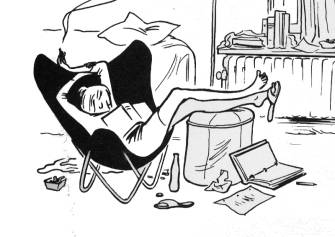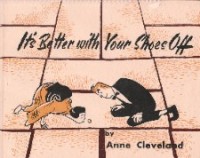
March 25, 2009
 Anne Cleveland, 1916-2009
Anne Cleveland, 1916-2009


Anne Thorburn Cleveland, a mid-century gag cartoonist who authored the stand-out book
It's Better With Your Shoes Off and who with and without frequent collaborator Jean Anderson published a number of books including several about life at women's schools in general, and her alma mater Vassar in particular, died last month in Oregon. She was 92 years old.
Cleveland was born in 1916 to a clergyman's family that included her twin brother and eventually two younger siblings. Her father died in the late 1920s from a blood infection contracted during World War I. Her mother supported the family by working what granddaughter Ursula
wrote in a comment to The Beat sound like jobs related to educational institutions, eventually becoming a dean at Rollins College in Florida.
Anne started at Vassar in the mid-1930s. She was a member of the class of 1937. Her granddaughter writes that she started as a classics major and then switched to art history. She would become editor of her senior yearbook, and contribute a number of cartoons to student publication and various decorations around campus. Fellow Vassar graduate Shaenon Garrity took several photos of public art on campus by Cleveland
for a short essay here, which includes both student work and later artwork that was likely created during a freelance period in 1944-45. In 1937-1938 she stayed on at the school's art department where she met 1933 graduate Jean Anderson, a prolific campus cartoonist right before Cleveland's time that had spent the intervening years practicing her craft at the Art Students League In New York.
Cleveland published a trio of books with the Vassar Cooperative Bookshop directly related to her alma mater, in partnership with Anderson:
Vassar (1938),
Vassar: An Informal Study (1940) (with text by Agnes Rogers; also called
Vassar Women) and
Vassar: A Second Glance (1942). The first one was a surprise hit. It sold several thousand copies and led to several Anderson and Cleveland cartoons being published in
Life, kickstarting each cartoonist's career.
Vassar Women was reviewed in a giant article by Harriet Anderson in the
New York Herald Tribune, where it was suggested that the book was as valuable a sociological treatise as the Lynds' work on
Middletown. A cartoon each from Anderson and Cleveland decorated that article. The cartoonists had a different view of their work, cheekily proclaiming later that
Vassar "absolutely stank." By the time the third book rolled around Anderson and Cleveland were able to work through long-distance collaboration, rare in those days. That book sold over 20,000 copies in four years.
The books with Anderson are interesting in one sense because rather than being a writer and an artist they were both cartoonists, each with a distinct but not clashing style. Anderson's work was perhaps a bit less stylized than Cleveland's but was equally lively. At times it seems that Cleveland would sign a work that appeared to be in Anderson's style, suggesting a closer collaboration than one might typically find between two cartoonists working on the same project. (Anderson would later enter medical illustration and then medical school.)
Says Garrity, "I first discovered her cartoons -- and Jean Anderson's -- when I picked up
Vassar: A Second Glance and
Everything Correlates at the campus bookstore, and for many years they felt like a private thing, these little snippets of college-girl life unknown to the rest of the world. Her Vassar cartoons are, well, very Vassar; as an alumna myself, I can attest that they capture all the peculiarities of the college -- well, all that are fit for print in
The Ladies' Home Journal."
Perhaps buoyed by the success of her work on Vassar, Cleveland began to do work outside of the shadow of her school. She provided illustrations for
A Home Of Your Own And How To Ruin It, with Henrietta Ripperger;
Weeds Are More Fun, with Priscilla Hovey Wright (1941); and
How To Do Practically Anything, with Jack Goodman and Alan Green (1942). She taught at Rollins College during 1941-1942. Entering the Women's Army Corps in 1943, Cleveland performed work in hospitals, did some mapmaking, created posters for training aids and worked on military film strips. She left the WAC in December 1944, returning to a freelancer's life.

After the war, she worked on another book with Jean Anderson, 1946's
Everything Correlates before an almost ten-year book publishing hiatus. It's possible that she was concentrating on family and home. Her marriage to Augustus R. White led to the time in Japan that yielded what was likely Cleveland's best-known book,
It's Better With Your Shoes Off. This books of cartoons about westerners living in post-War Japan came out in 1955. It put on display a significant leap in Cleveland's artistic talent: while she may not have been published in book form since right after the War, it was clear from the linework reminiscent of Gluyas Williams that she had never stopped drawing.
The cartoonist Seth would later write of what he termed "a beautifully designed little book" in his
Forty Cartoon Books Of Interest:
The book is unusual is several ways. For one, it appears to have been designed as an original book and not a collection of previous material. Also, it never panders -- it's sweet bu it's also a serious attempt to find humour in a subject that may be unfamiliar to a general audience (the culture shock of going to Japan). And best of all -- it is almost undated. It never sinks to cheap racial humor. It has class."
Seth told
CR earlier today that this one of Cleveland's works was still being published in new editions years later.
I first came across Anne Cleveland's work back in the 1980s when I stumbled across a new edition of It's better with your shoes off in a local bookstore. In retrospect, it amazes me that her book was still being reprinted at that point -- decades after it came out. It was just a little paperback but I immediately fell in love with her brilliant drawings and her smart, innovative layouts. The book was funny and gentle as well. I knew nothing about her and, truthfully, I have found out only a little more in the decades that followed that discovery. But it wasn't because I wasn't interested. I put her on my "must find" list and spent those decades looking for more of her work. It was few and far between, but I found another three or four books of her work including a couple of books of cartoons she did for Vasser and a beautiful children's book, The Life Savers. However, it was that first book that stuck with me the most. I was so happy (in those pre-internet days) to chance about an original hardcover of it in the early '90s and it really has stayed a prized possession. It's a beautiful object -- lovingly designed and printed."
It's Better With Your Shoes Off was the first in a final flurry of Cleveland works that included the solo outings
The Parent From Zero to Ten (1957) -- which included cartoon anecdotes taken from her own family, her son Toby later confirmed -- and the Seth-mentioned
The Life-Savers (1962). There were also three more collaborative works,
But I Wouldn't Want To Live There, with Heather Jimenez (1958);
The Educated Woman in Cartoon and Caption again with Jean Anderson and I believe either in the vein of their earlier work or reprinting some of it (1960); and
Straw In My Camel's Hair, with Naida Buckingham and Ingrid Etter (1961).
According to a 1946 biography by the Vassar Cooperative Bookshop in support of
Everything Correlates, Cleveland did a series of cartoons for the
Ladies' Home Journal during the first part of her career. She and Jean Anderson did another set for
Haper's Bazaar. Her family believes her clients may have included
The New Yorker, although no record of her cartoons having appeared in the latter is available through their cartoonbank database. That publication's illustrations are not indexed in the same way, and Cleveland's style could certainly have found purchase there.
The Life-Savers seems to have been Cleveland's last published book, when she was only in her mid-forties. She and her husband divorced in 1965. According to the information supplied by Ursula at
The Beat, Cleveland spent time in New York, then moved to Ashland, Oregon where she stayed until the 1980s when she moved back east to be near her daughter. She moved to Portland, Oregon in 1992, again to be near family.
Seth recalls Cleveland as a talented artist of a specific mid-20th Century tradition and as a cartoonist he wishes had been able to publish more work.
"Cleveland has always seemed artistically linked in my mind with the Canadian Doug Wright. They had a similar approach to cartooning the figure: strongly grounded in a deep observational understanding of the human body but brought to life on the page with a gorgeous clear-line drawing style. And they both applied a masterful design sense when stylizing the figure -- abstracting it but never losing or covering up the reality of direct observational knowledge. That's really the secret to her work. It is stylized and it has a sensual veneer but when you look at it you know that you are looking at an artist who has the magic touch to genuine cartoon the real world -- capturing the subtlety of detail and nuance to actually get a "feel" of experience onto the page. It's a virtuoso act. Which makes it a shame that so little of her work seems to have been done. I wish there were 20 Anne Cleveland books out there. She was great and I can only fantasize some dream projects for her."
Although she declined interview requests in recent years, members of her family including grandchildren became aware of discussion about and appreciation of her work on-line. "I will be seeing her in a few days," wrote one family member early this year, "and will let her know that she seems to have become better known that she would ever have believed. It will be a considerable comfort to her, I suspect."
 posted 8:00 am PST
posted 8:00 am PST |
Permalink
Daily Blog Archives
November 2019
October 2019
September 2019
August 2019
July 2019
Full Archives


